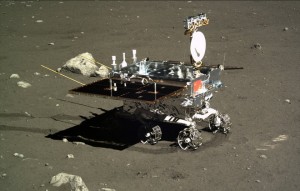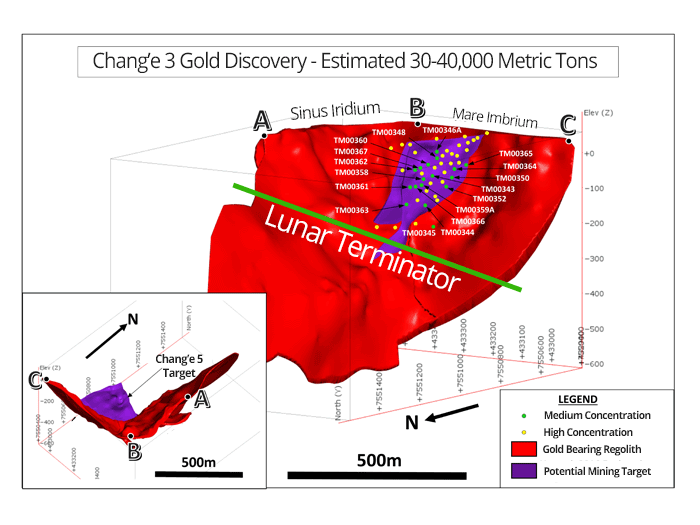Off-earth gold mining could become a reality in 3-5 years, as China announces plans to mine and refine 16,000 MT of lunar gold by 2030.
 Bullion.Directory precious metals news 1 April, 2017
Bullion.Directory precious metals news 1 April, 2017
By Alison Macdonald
Science Editor at Bullion.Directory
 The newly announced finding of “significant” gold placer deposits in the Sinus Iridium region of the moon were discovered as part of The Chinese Lunar Exploration Program’s (CLEP) Chang’e 3 mission.
The newly announced finding of “significant” gold placer deposits in the Sinus Iridium region of the moon were discovered as part of The Chinese Lunar Exploration Program’s (CLEP) Chang’e 3 mission.
Named after the Chinese moon goddess Chang’e, the Chang’e 3 successfully soft-landed on the Moon on 14 December 2013 and deployed a 140 kg (310 lb) lunar rover named Yutu (Jade Rabbit) with a mission to study the geology of the moon.
Despite China’s State Administration for Science, Technology and Industry for National Defense (SASTIND) announcing on 3rd August 2016 that Yutu had stopped operating 31 months after landing, yesterday’s revelations have shown it to have continued it’s mission, in secret, after the discovery of “significant quantities” of near-surface gold.
Geologist, Ouyang Ziyuan was among the first to advocate the exploitation of known lunar reserves of metals – and helped lead a push forming the basis of the Chang’e 3 mission, under CLEP’s chief chemical cosmologist Dr Yúrén Jié.

YUTU’s multi-billion dollar sensors located gold. Credit: CASC/China Ministry of Defense
Setting Yutu’s route to study local regions flagged by orbital missions Chang’e 1 and 2 as “potentially” bearing gold deposits, Dr Jié said yesterday that the first gold was found on May 04, 2014.
“We began to find small quantities of placer gold at the liminal point between the fine lunar dust surface and an underlying strata of lunar basalt… at first Yutu was detecting 1g of gold in approximately 5 metric tons of regolith… as [Yutu] progressed north, find ratios increased to 1g in 1 metric tons, 1 in 500kg, then 1 in 100kg. At that point we knew we had a major discovery”
A decision was made to close the program [from outsiders] giving us the time to verify the finding and prepare a sample return mission later in 2017”
Chang’e-5 will launch at the end of November this year, from the Wenchang Space Launch Center in southern China’s Hainan Province, aboard heavy-lift rocket Long March-5.
Chang’e 5 will see a lunar orbiter release a lander to touch down on the moon’s surface and collect 2 kilograms of gold-bearing dust. The mission will make an automatic rendezvous and docking with the return module in lunar orbit before flying back to the Earth.
Zhè Shì Huǎngyán, lead metallurgist for the Chang’e 5 mission said in a briefing at Wechang, Friday, “Concentrations at our proposed landing site are inexplicably high. We are seeing over 1kg of gold per cubic meter of regolith lying as a placer deposit 20-60cm below the surface. I can’t explain it. None of us can explain it. We can theorize that the moon’s violent past could be responsible in some way, but until we have more specialized equipment on the ground we are only guessing.”
To put these concentrations into context, on earth you need to mine between 2-100 tons of rock to find 1oz.
Initial estimates suggest there could be as much as 30-40,000 MT near-surface gold in the region between Sinus Iridium and the lunar terminator to the north.
Huǎngyán said “Concentrations increase exponentially towards the lunar terminator and may do so beyond this, however the Jade Rabbit was unable to venture into the dark zone due to telemetry and control issues. We will rectify this failing with Chang’e 5 and 6, expanding our search area beyond the lunar terminator.”

When asked about the practicalities of mining and refining the lunar gold, Dr Avril Abruti spoke on behalf of the newly-formed Chinese / Canadian mining partnership Jīnfēng (Golden Maple), “Much of what we’ll be doing is very similar to terrestrial mining technology, using largely automated and remote-controlled systems to extract and sift the gold from the regolith. Smelting and refining will see locally-sourced fuel – helium3 – harvested and used as a power source, but the rest of the process is very much as it’s been done for millennia.”
The most expensive part of the process would be returning the gold to Earth, but really, ask yourself, do you actually need the gold [on Earth]? Why can’t we vault it at source? Seriously, can you get better security than being on the moon?”
Reacting to the news of the partnership, Russian sources admitted “surprise” that China had selected Canada as their partner in future lunar missions, especially after Anatoly Perminov, head of the Russian Federal Space Agency, revealed in 2006 in RIA Novosti that Russia and China were working on lunar exploration as partners.
Probed about Russia’s perceived snubbing, Dr Abruti joked “Who else would China go to? We’re Canadian. We’ve got goldrush fever running through our DNA”.
What Effect Will Lunar Gold Have On Terrestrial Gold Prices
Conservative estimates price the Chang’e 1-6 missions at over $1 Trillion, combined. If the Chang’e 5 mission is able to successfully return even 1oz of lunar gold to our planet, that’s quite a premium over spot.
But what of China’s projected mining and refining of 16,000 metric tons by 2030?
16,000,000kg of gold at today’s price would “only” be worth $635,040,000,000 – and adding the original mission costs to the costs of mining, refining and sending this gold back to earth would still see the project run at a huge loss.
However, that’s a huge loss when priced as terrestrial gold.
Considering a federal court set the value of the moon rocks at $50,800 per gram based on how much it cost the U.S. government to retrieve the samples between 1969 and 1972 – the same could be said for lunar gold.
Provided there is an iron-tight chain of custody from the lunar operation to investor’s hands back on earth, we could easily see lunar gold trading independently of it’s terrestrial equivalent at many multiples of value.
In fact it wouldn’t be hard to imagine “regular” gold losing a little shine alongside it’s heavenly competitor, where the new kid on the block has a higher intrinsic value based on it’s on-earth rarity, if as suggested by Dr Abruti the bulk of the refined gold is vaulted on the moon.
The Legalities of Lunar Gold Mining
Can China really lay claim to the gold found on the Chang’e 3 mission? The 1967 United Nations Outer Space Treaty, specifically states that no nation can claim ownership of the moon.
Law experts question whether this treaty could prevent private ownership. There’s nothing stopping miners claiming property rights and using the moon as a commercial venture.
Claims of ownership are already causing legal issue for the Golden Maple consortium – with Basildon-based pensioner Allan Hundingdon planning to sue the Canadian party over what he calls “theft of lunar assets”.

Mr Huntingdon has vowed to fight for full compensation
“The Chinese and Canadians have no legal right to take anything from my legally-titled land without my prior consent. I will be pursuing them for fair compensation.”
Mr Hundingdon paid £16.95 for the title including tax.
Representatives at Golden Maple are not commenting on the claim as it is an “ongoing legal dispute”, however an un-named expert on space law said “much of this is based on a declaration of ownership filed in 1980 by Mr. Dennis M. Hope through the UN as well as the US and Russian governments. Mr Hope, of the self-styled Lunar Embassy, says this ensures a legal basis for the ownership of the lunar properties sold.”
It’s my belief that only boots on the ground can constitute a valid claim – in this case China’s $1 trillion investment probably trumps Mr Hundingdon’s £16″
NASA are quoted saying “The reality is until we get there and fight it out we’ll just have to wait and see.












 Material provided on the Bullion.Directory website is strictly for informational purposes only. The content is developed from sources believed to be providing accurate information. No information on this website is intended as investment, tax or legal advice and must not be relied upon as such. Please consult legal or tax professionals for specific information regarding your individual situation. Precious metals carry risk and investors requiring advice should always consult a properly qualified advisor. Bullion.Directory, it's staff or affiliates do not accept any liability for loss, damages, or loss of profit resulting from readers investment decisions.
Material provided on the Bullion.Directory website is strictly for informational purposes only. The content is developed from sources believed to be providing accurate information. No information on this website is intended as investment, tax or legal advice and must not be relied upon as such. Please consult legal or tax professionals for specific information regarding your individual situation. Precious metals carry risk and investors requiring advice should always consult a properly qualified advisor. Bullion.Directory, it's staff or affiliates do not accept any liability for loss, damages, or loss of profit resulting from readers investment decisions.

Leave a Reply